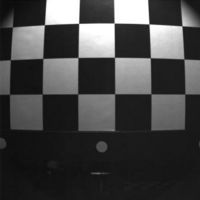Difference between revisions of "High Speed Vision System and Object Tracking"
| Line 2: | Line 2: | ||
__TOC__ |
__TOC__ |
||
=Calibrating the High Speed Camera= |
=Calibrating the High Speed Camera= |
||
[[image:Distorted_calibration_grid.jpg|thumb|200px|'''Figure 1:''' Calibration grid with distortion.|right]] |
|||
Before data can be collected from the HSV system, it is critical that the high speed camera be properly calibrated. In order to obtain accurate data, there is a series of intrinsic and extrinsic parameters that need to be taken into account. Intrinsic parameters include image distortion due to the camera itself, as shown in Figure 1. Extrinsic parameters account for any factors that are external to the camera. These include the orientation of the camera relative to the calibration grid as well as any scalar and translational factors. |
Before data can be collected from the HSV system, it is critical that the high speed camera be properly calibrated. In order to obtain accurate data, there is a series of intrinsic and extrinsic parameters that need to be taken into account. Intrinsic parameters include image distortion due to the camera itself, as shown in Figure 1. Extrinsic parameters account for any factors that are external to the camera. These include the orientation of the camera relative to the calibration grid as well as any scalar and translational factors. |
||
In order to calibrate the camera, download the Camera Calibration Toolbox for Matlab, which can be found [http://www.vision.caltech.edu/bouguetj/calib_doc/ here]. This resource includes detailed descriptions of how to use the various features of the toolbox as well as descriptions of the calibration parameters. |
|||
==For Tracking Objects in 2D== |
==For Tracking Objects in 2D== |
||
To calibrate the camera to track objects in a plane, first create a calibration grid. The Calibration Toolbox includes a calibration template of black and white squares of side length = 3cm. Print it off and mount it on a sheet of aluminum or PVC to create a stiff backing. This grid must be as flat and uniform as possible in order to obtain an accurate calibration. |
|||
Following the model of the [http://www.vision.caltech.edu/bouguetj/calib_doc/ first calibration example] on the Calibration Toolbox website, use the high speed camera to capture 10-20 images, holding the calibration grid at various orientations relative to the camera. 1024x1024 images can be obtained using the "Moments" program. The source code can be checked out [http://code.google.com/p/lims-hsv-system/ here]. |
|||
One of the images must have the calibration grid in the tracking plane. This image is necessary for calculating the extrinsic parameters and will also be used for defining your origin. |
|||
==For Tracking Objects in 3D== |
==For Tracking Objects in 3D== |
||
=Using the High Speed Vision System= |
=Using the High Speed Vision System= |
||
Revision as of 12:29, 6 June 2009
Last modified 6 June, 2009
Calibrating the High Speed Camera
Before data can be collected from the HSV system, it is critical that the high speed camera be properly calibrated. In order to obtain accurate data, there is a series of intrinsic and extrinsic parameters that need to be taken into account. Intrinsic parameters include image distortion due to the camera itself, as shown in Figure 1. Extrinsic parameters account for any factors that are external to the camera. These include the orientation of the camera relative to the calibration grid as well as any scalar and translational factors.
In order to calibrate the camera, download the Camera Calibration Toolbox for Matlab, which can be found here. This resource includes detailed descriptions of how to use the various features of the toolbox as well as descriptions of the calibration parameters.
For Tracking Objects in 2D
To calibrate the camera to track objects in a plane, first create a calibration grid. The Calibration Toolbox includes a calibration template of black and white squares of side length = 3cm. Print it off and mount it on a sheet of aluminum or PVC to create a stiff backing. This grid must be as flat and uniform as possible in order to obtain an accurate calibration.
Following the model of the first calibration example on the Calibration Toolbox website, use the high speed camera to capture 10-20 images, holding the calibration grid at various orientations relative to the camera. 1024x1024 images can be obtained using the "Moments" program. The source code can be checked out here.
One of the images must have the calibration grid in the tracking plane. This image is necessary for calculating the extrinsic parameters and will also be used for defining your origin.
